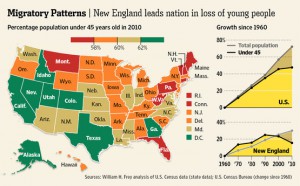redo Jump to...
print Print...
(by Jennifer Levitz, The Wall Street Journal, WSJ.com) MANCHESTER, N.H. – Matt Marshall is still trying to determine which path he will take when he graduates from the University of New Hampshire in June. But the 23-year-old business major has pinpointed his general direction: out of the state.
“I definitely want to go someplace else. Where, I don’t know, but I’ve lived here all my life,” he said, mentioning a warmer locale as his possible future home. “I hate snow.”
 New Hampshire is giving the spiky-haired Mr. Marshall anything but the cold shoulder. With census figures showing New England leads other parts of the U.S. in the decline of its under-45 age group, the Granite State and its neighbors are desperate to keep young people around.
New Hampshire is giving the spiky-haired Mr. Marshall anything but the cold shoulder. With census figures showing New England leads other parts of the U.S. in the decline of its under-45 age group, the Granite State and its neighbors are desperate to keep young people around.
Massachusetts is funding internships at private companies—$2.2 million this year, up from $1 million last year. In a pilot program started in July, Vermont is forking over cash to graduates who stay in the state.
New Hampshire, under the direction of a young-worker retention task force established by Democratic Gov. John Lynch, has launched a nonprofit called Stay Work Play to sell the state to college students. The state also is directing one-third of its entire marketing budget toward wooing and retaining younger people.
“I can’t think of anything more important,” said Steve Boucher, legislative director of the New Hampshire Division of Economic Development.
Despite New Hampshire’s relatively low unemployment rate of 5.4% as of September, officials have found that about half of all college students leave the state after graduation, believing they need to head to a big city to find a robust social life.
Among the events planned is a “college invasion tour,” featuring comedians and concerts, to help show a fun alternative to New Hampshire’s “traditional Yankee” side, Mr. Boucher said.
Regional officials say their retention programs are new, so they are still measuring the effects. Students who have been courted by the states have mixed reviews.
Ariana Chehrazi, a Massachusetts Institute of Technology senior, had been planning to return to her native Los Angeles after graduation, but changed her mind after landing a summer internship at a diagnostics firm through the state program. Los Angeles doesn’t “have the same feel as wanting to keep you here.…Massachusetts is trying harder to get young people,” she said.
But 22-year-old Brian Iwanicki, a New Hampshire native, said it wasn’t easy to find “a hip place that a young professional might want to go” in Manchester, New Hampshire’s biggest metropolis. “It’s a short list,” he said.
Still, 10 networking groups for young professionals have cropped up across New Hampshire—which state leaders see as an indicator that retention efforts are working.
The loss of young people is one factor in New England’s slow growth, which puts the region at the forefront of a nationwide aging trend. State leaders in the region say innovation depends on smart, young people and many officials see the signs of that base dwindling. Maine Gov. Paul LePage, a Republican, said last week that employers have been complaining to him about a shortage of skilled workers.
Another worry: potential loss of political clout. States that lost congressional seats after the latest census were primarily in the Midwest and Northeast, including Massachusetts.
New England’s population grew 3.8% in a decade, the 2010 census found, compared with the U.S.’s 9.7% overall growth. The population continues to shift South and West because of a combination of weather, cost of living and relatively low-skilled jobs for newcomers, said Brookings Institution demographer William Frey.
With fewer people arriving, New England leads in the graying of its population. Of just seven states with a median age of 40 or older, four are in New England: Maine (42.7), Vermont (41.5), New Hampshire (41.1) and Connecticut (40.0). There are bright spots—Boston continues to gain young people—but each New England state saw a decline in the under-45 group. Meantime, Arizona’s under-45 population jumped 16%.
On a recent night, Stay Work Play New Hampshire visited the University of New Hampshire’s Manchester campus. “It’s easy to get the perception there is nothing to do…but I’m constantly amazed that there is a lot of stuff happening” in the state, said Kate Luczko, the program’s executive director.
The message rang true to Brian Bishop, a 22-year old who said he wouldn’t likely head South or West. “I lived in Florida for a year and a half,” he said, with a sour expression. “It’s too slow-paced, too much small talk. Here we try to get things done.”
Write to Jennifer Levitz at jennifer.levitz@wsj.com.
Copyright 2011 Dow Jones & Company, Inc. All Rights Reserved. Reprinted here for educational purposes only. Visit the website at wsj.com.
Questions
1. a) List the New England States.
b) Describe the challenge regarding population faced by New England states.
2. What are various New England states doing to alleviate their population problems?
3. How are college students responding to attempts to keep them in New England after graduation?
4. What types of problems do the states face when too many young people leave after school?
5. a) To what areas of the country is the population shifting?
b) Why is the population shifting to these regions?
6. a) Do you think state funded internships (as in Massachusetts) or giving cash to grads who stay (as in Vermont) will successfully keep young people in New England long-term? Explain your answer.
b) What other solutions do you think New England states could try to prevent young people from leaving the state?
Daily “Answers” emails are provided for Daily News Articles, Tuesday’s World Events and Friday’s News Quiz.



